Halter training for a domesticated colt
 I have realized that most journals skip from the Joining-Up exercise right to the next exercise done with the horse wearing and being controlled by a halter. It isn’t a magic transition. A horse who has taken you as his partner is not halter-broke by any means.
I have realized that most journals skip from the Joining-Up exercise right to the next exercise done with the horse wearing and being controlled by a halter. It isn’t a magic transition. A horse who has taken you as his partner is not halter-broke by any means.
I had the opportunity recently to introduce a colt to both Joining Up and his first voluntary haltering (at liberty in the round pen). Kristull High Water Mark is a 9 month old 3/4 Friesian colt. He was imprinted at birth and has been approached, given treats, and rubbed over much of his body about once a week in the open pasture during his first few months. He is not “wild” like a Mustang or Australian Brumby. However, he could always run away with impunity, and getting a halter on him (the two times he was haltered) required three people pinning him in a corner, slipping a lasso over his head and wrestling him into the halter with much drama, fighting and danger. He had never had any round penning or joining up exercises. No one had ever “taken control” from him.
The video above shows the easily-caught and haltered horse at 2 years of age. The still pictures show his progress after two sessions of round-penning. He has Joined, but is afraid of the halter. Any close contact with it sends him startling, twirling and running away. Realize that we are doing this at liberty. He is not being bullied or made to feel that he can’t get away. Read more about Fight or Flight Instinct.
The entire exercise is based on the principles of Round-penning (to get him to stand near me) and desensitizing (to accept contact with the handler and the halter).
Step one: Stop, face me and allow me to approach. We have conquered that thanks to his round-penning experience. He even comes to me in the middle of the pen most of the time.
Step two: Approach and Rub. Approach him indirectly and start rubbing his chest, slowly up his neck on both sides, the sides of his face, and ultimately his ears and poll.
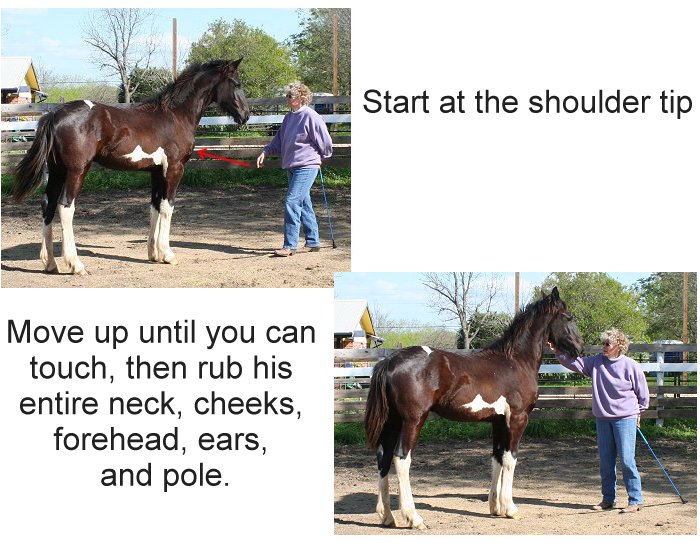
All accomplished by day 2 thanks to his imprinting and early pasture handling. (It will take you longer if your horse is more skittish, and this is not possible nor recommended with a horse who has never been handled at all. A wild colt is dangerous and must be thoroughly de-sensitized to touch starting at a safe distance with a handy-stick first.)
I will start this colt by touching/rubbing at the points of his shoulders and work my way up.
Notice that my stick is out of site. He is tolerating my direct eye contact, but your horse may need a less direct approach. I have even turned my back on a horse and approached from an angle 45 degrees of his shoulder tip, backing into him slowly (able to look under my arm to watch his reaction) until I could reach behind me to touch and then stroke his shoulder. It all depends on how skittish your horse is.
If he jumps away, send him around the pen two or three times so that he begins to see a difference between easy standing or hard work. Then repeat the approach, rub, retreat until he is de-sensitized to your hands.
Step three is to let him investigate the halter. During this phase his young age helps. He is curious and wants to taste the new piece of equipment.
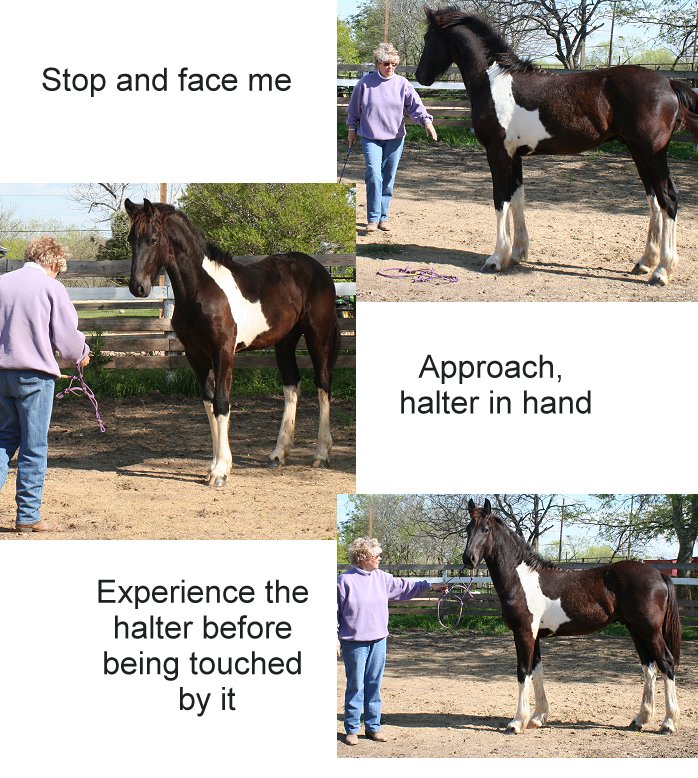
 He watched it in my hand. He watched it lying on the ground. He watched it being pulled away from him, dragging across the ground. When it came close to his mouth, he lipped, then took it from me, actually holding on in a small tug-of-war a couple of times. So far, so good. * (see comment below)
He watched it in my hand. He watched it lying on the ground. He watched it being pulled away from him, dragging across the ground. When it came close to his mouth, he lipped, then took it from me, actually holding on in a small tug-of-war a couple of times. So far, so good. * (see comment below)
The next steps follow many of the routines in the De-sensitizing instructions. I began to swing it gently back and forth, looking for his comfort zone: the place where he was not worried enough to move away from it. Having established that point, I began to move closer, retreating to release the pressure if he leaned back but did NOT leave me. If he actually took off, I picked up my handy stick and required him to make a couple of trotting circles around the pen. It didn’t take very long before he was evaluating the choice: stand a little uncomfortably or trot. Deal! Stand it was.
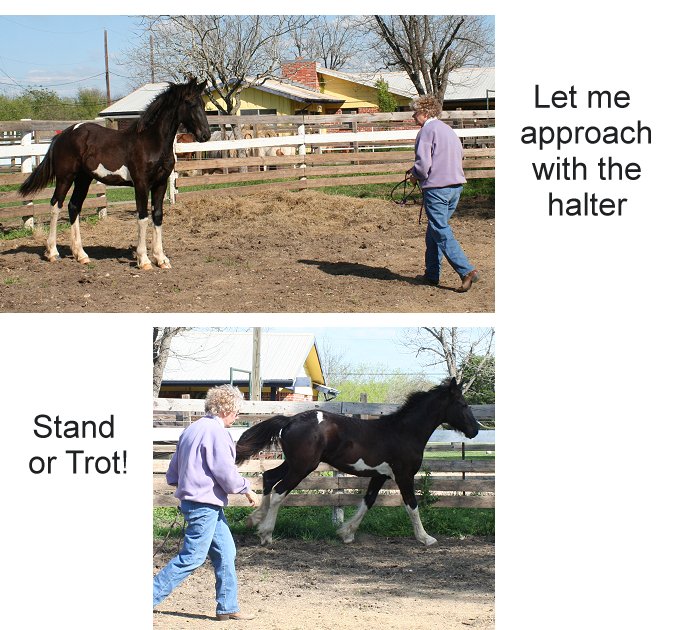
Now he must learn to tolerate it actually touching him. I started that by swinging and swaying it a little closer and closer to his chest until it was tapping him ever so lightly. With this particular colt, his chest was far less sensitive than higher up on his neck. Eventually I was actually tapping his nose. The first three or four nose-taps sent his head flying up and he made a couple of trotting circles around the pen. (You may be standing in front of him. Be careful that he has somewhere to go if he freaks out.) At last he decided it was easier to tolerate the tapping than to work at circling.
Now tap on up the side of his neck. Again, be careful that he has somewhere to go if he spins away. Don’t back him into a fence where he has nowhere to go except to jump on top of you. We had a few startles, jumps, and mini-explosions that sent him around the pen a few more times. But little by little, you could see him make the calculation each time he got anxious: stand a little uncomfortably or trot. Deal! Stand it was.
Step 4 involves getting the halter closer with some conviction. After he tolerates the tapping, try to rub him with it. First his close-side and then his off-side. Stand 45 degrees to his shoulder to avoid his jumping into you if he startles. De-sensitize both sides to the rubbing halter that has a little “dangle” to it.
If you have done the de-sensitizing to its touch on both sides he will stay still. If not, back up to more rubbing (to camouflage the reach-over) or the tapping (to get him more de-sensitized to the halter touch). Don’t rush through this. A horse who is quick to approach you and get his halter situated is a Godsend for life. A few extra sessions is well worth it.
Step 5 The Muzzle Mount Try to put it over his nose with no reach-over. Approach him as you did when he “tasted” the halter. He is used to having it touch his mouth and muzzle by now. Lift is up to fit it over his muzzle fairly firmly. If he backs up, follow him to the best of your ability. If he moves backward too fast, give up and send him off trotting again.
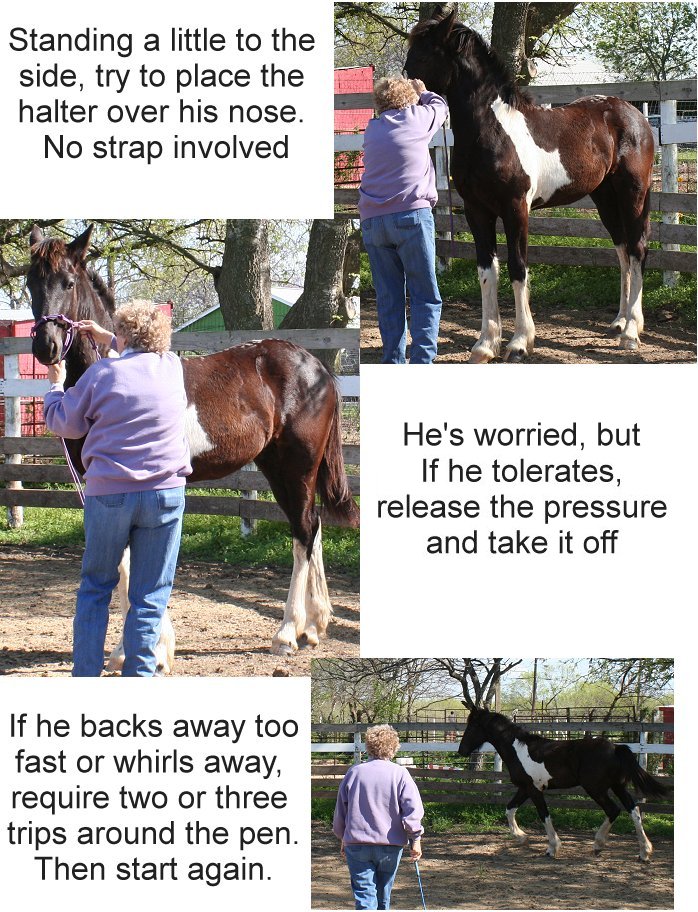
Step 6: The reach-up When he takes the halter on his muzzle easily, we will give him his first “hug”. Stand 45 degrees to his close-side shoulder. Holding the halter strap in your left hand, reach under his throat and rub his off-side letting the halter dangle as you rub. Now rub his close-side simultaneously. Rub a little bit on both sides taking note of his reaction to the dangling halter in your left hand. (You should be off to his front-shoulder side but “hugging” his neck. If he is OK with the dangling halter and your rubbing on both sides, see if you can reach over his neck with your right hand as if you are taking the halter strap over his poll.
If he is too spooky to touch and rub near his head and ears, he is not ready for this step. Back up to De-sensitizing those areas to touch before you proceed.
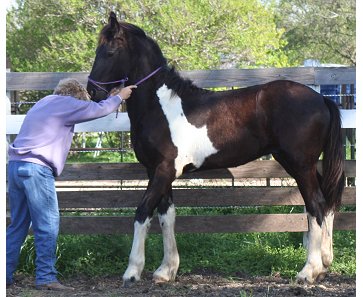 This accomplished, place the halter over his muzzle, and repeat the hugging routine. Take care not to immediately put pressure on the poll strap. He should feel it on his neck (probably a little below his poll if he is a very tall horse), but don’t try to restrain him from moving away. Follow him if you can, and let go to send him off longing if you can’t follow. (this colt is backing away from me but not getting frantic yet)
This accomplished, place the halter over his muzzle, and repeat the hugging routine. Take care not to immediately put pressure on the poll strap. He should feel it on his neck (probably a little below his poll if he is a very tall horse), but don’t try to restrain him from moving away. Follow him if you can, and let go to send him off longing if you can’t follow. (this colt is backing away from me but not getting frantic yet)
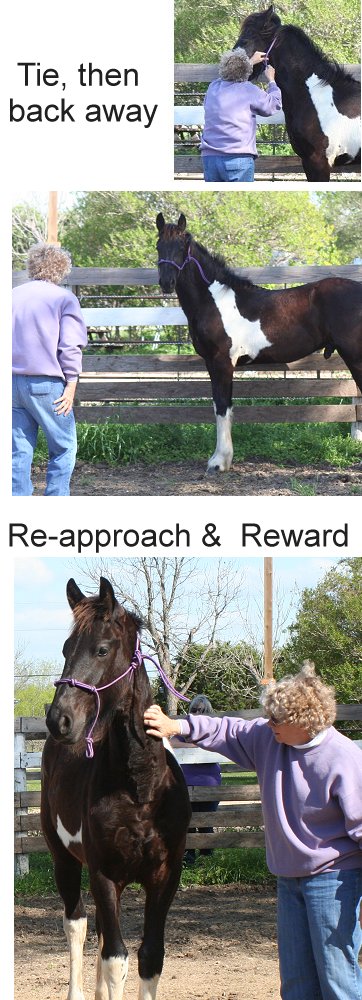
Step 7: Almost there. A few successful muzzle mounts and hugs will get you a horse who stands perfectly still while you put the muzzle on and pass the strap over his neck. Now just move the strap up to his poll and gently tie the halter. Then back away.
If he takes off, require a couple of turns around the pen with his usual halt and face at the end.
If he stands calm and resigned, re-approach, reward, and back away again.
It is very important to note that this is all being done (and is BEST done) with no restraints. If your horse has not been adequately round-penned and joined up, he is NOT ready for this. It is dangerous with a horse who could bolt or turn on his heels and kick. An adequately joined horse has already learned to never show you his fanny. Still, you must be careful to stay out of the way of a skittish horse who might jump forward into your space on top of you.
Additionally, your horse should have had some de-sensitizing to touch and rub on his body. You should not try to halter a wild, untouchable, volatile horse using this abbreviated method.
 What happens when you attach the Lead?
What happens when you attach the Lead?
This baby got to “lip” and chew the lead and buckle much as he did the halter. He is very oral, like every other baby in the world. It is a very easy way to introduce him to equipment he has not experienced up close before. * (see comment below)
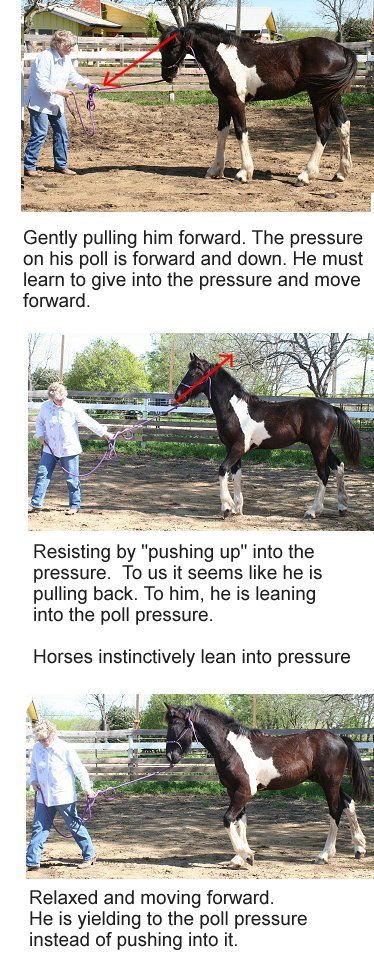
Start Leading: Stand facing your horse about 8 feet away, bent a little at the waist, not intimidating him in any way. INVITE him to move toward you by putting a little pulling-pressure on the rope. This could go one way or another. He might surprise you and take a step forward. If he does, you take a step back. Relax a few seconds and repeat the exercise. One step at a time in baby steps until he is coming toward you calmly a few steps at a time. If you take a step back every time he takes a step forward on your cue, he will be moving smoothly forward with minimal poll pressure in no time.
OR…..the first time your colt feels the poll pressure of the halter as you try to move him forward, he may become very upset. He could go from planting his feet to a backward-flying panic when he realizes that he is restrained. Remember Pressure. Horses naturally push into physical pressure. If you lean against him, he will lean back. As you pull him toward you, he is feeling pressure down and forward on the poll. His natural reaction will be to move up and back pushing back up INTO the pressure. He needs to learn to yield to the pressure instead of pushing against it.
If he panics, don’t just plant your feet and try to hold him as he flies up and backward. The less you give, the more claustrophobic and frightened he will become. Hold onto the rope, but give him some play to race backward. Go with him. He might even half-drag you with him, but hang on and go. When he stops you stop instantly and release the pressure. Stand and relax. Stop is good.
After a couple of minutes of standing, looking at each other, ask him to approach again. If he takes even one step forward, stop pulling immediately and back up. Stand and relax. If he flies backward again, repeat the first procedure.
This doesn’t usually take more than a few tries to get him to move forward when you ask.
I have seen a couple of horses panic, hit the end of the rope, and actually rear themselves over backward. It is most common with a wild horse who has been lassoed or force-haltered then given enough rope to get up a pretty good head of steam running away. This would rarely be the case if the horse has been properly round-penned, the handler is using a 14′ lead and allows enough play for him to run backward without too much resistance.
Thank you Kristull Ranch in Austin, Texas for letting me use your horses to demonstrate.
Horse training can be dangerous. Not all methods work on all horses. Instruction presented here is not meant to be prescriptive in nature, and Horse-Pros.com takes no responsibility for the welfare of any animal or person using our methods.
We certainly don’t know everything. Please share your expertise and experiences. Comment on what is already written or Suggest a Category and Educate us about it. Grow Horse-Pros.com©

Hello. I acquired a 4 year old mare and her 1 month old stud colt in June. It is now February and I have been working with the colt for 3 weeks at least an hour at a time doing liberty but he keeps running from me. The only way I can get him up close is by sitting down, then he will walk up to me. I have been playing with the halter all over his face and head and he is comfortable with that, even standing up from a sitting position…..but as soon as I try to bring the closure of the halter hr bucks up and leaves. He has been a pushy colt as well. He has been challenging as I have never had a colt or Philly that I couldn’t halter. He needs his feet done so I am frustrated that I ca not even get a halter on him so I can go further with liberty.
Can u send me a video of a stubborn colt who makes it difficult for you to get ‘close’ and some tips on getting him to soften.
Hi Deb: So he is 9 months old now?
He must be desensitized to the look and wiggle of the halter before anything else. It sounds like he is fine there. Does he tolerate having his ears rubbed and you playing around with the top of his head? Can you rub his head and “scrub” the top of his head with the halter in hand? Or is it the nose loop sliding on that starts the bucking up? Are you using a rope halter or a nylon halter? Can you cup and rub his muzzle and face without the halter? I’m not sure of exactly where he starts the serious objecting.
What do you do when he bolts off? Do you ask him to circle the round pen again so that he finds that his action causes him to be told to move. Then he can make a decision about the two activities: “Do I like to run around the pen, or would I rather stand still?”
I’m not a fan of sitting in the round pen to get him to come to you – especially with some stud colts who can take dangerous advantage of that. If you are making yourself smaller (sitting) so that he is not intimidated, then you are doing something wrong with the round penning and join up when you are standing. Try not sitting but turning your back on him when he stops. That will make you less intimidating without tieing your legs together. (You can keep an eye on his demeanor kind of serrupticiously by sneaking peaks if you don’t trust him to approach gently.)
This whole exercise should not take an hour. He should circle the round pen at liberty for just a few minutes, then stop and join up. Start the haltering process then. You should be able to do this at least 10 times in an hour. Each time he stops you try to halter. Each time he runs off you make him circle at a canter 4-5 times around the pen. Then start over.
I have occasionaly had to use some “creative” ways to catch and halter a colt. Unfortunately I don’t have any videos.
The most successful “trick” has been to round pen the guy for a few minutes, turn my back on him when he stops so he will approach me (or slowly back up to him at the edge of the round pen). Stand 45 degrees to his shoulder with my back to him. Reach behind me and start running my hand from point of shoulder up his neck to behind his ears while still facing away. After a few sessions of this, I repeat the process with the halter in my hand – now rubbing up his neck with the halter dangling (I use a rope halter because it is less “big” and intimidating.)
Don’t ask too much. Ask that he stand still and get rubbed. If you can turn your body a little toward him over time, do that. But if not, it is possible to halter him almost exclucively from this backward positiion as you can mount the nose of the halter with your left hand and slide the tie up with your right hand that has made its way up to his ears. Don’t actually tie it at first. Get him used to having it mounted on his nose and dragged up a tad, then release the pressure.
Rub his face. As he gets more tolerant, start reaching (rubbing) under his jaw with your left hand after you have mounted the nose loop, because that hand will eventually have to send the halter up the far side of his face and over his ears to meet your right hand. After a few sessions of this activity, you can usually manage to tie the halter in place. Tie it quickly even if not tight. Just make it secure enough that it won’t fall off. It is not necessary to leave it on him or try to control him with it at first. Just get him used to wearing it for a minute and then take it off. If he bolts with it tied, let him take a few turns around the round pen again, then back up to him and repeat the whole procedure to take it off.
I hope this helps.
I just purchased a 7 month old colt …I’ve never had one before… horses yes but everything was already done on them and for them.. neck reining , bridle etc came with …so this is all new to me…
what do you suggest timing and size wise…I would like to ride western.. in due time but I also have to work with him on this.. any ideas he’s now wearing a cob halter it’s a little big on him ..so when should I even introduce bit/snaffle etc … sorry but yes I’m totally new at being a new mom ..and would like to do it right to begin with ..thanks
You don’t tell me what type of colt you have. I start all of my young horses in a knotted halter such as Clinton Anderson or Parelli. It has authority from the beginning. I don’t put a bit in their mouth until we are actually riding, and I never ride until they are at least 3 yrs old and their knees are knitted (some breeds can start at 2 yrs). By then they can do everything on the ground that they will be expected to do under saddle, and riding presents fewer challenge. Many of my western trail horses never wear a bit at all – instead continue in their halter with reins or use a side-pull or bosal hackamore. Either read the rest of this site about horse training theory and then horse training lessons, or get into Parelli or Clinton Anderson natural horsemanship training where you can find any number of mentors. You have the perfect opportunity to bring him along with ease. Good luck and happy trails.